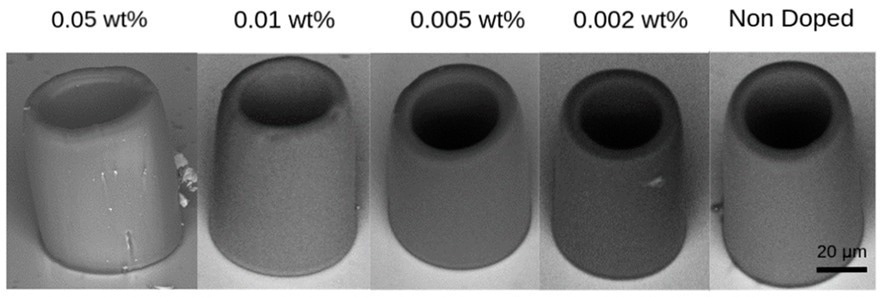A nitrogen-vacancy (NV) center is a flaw in the diamond crystal structure that occurs when an adjacent lattice site becomes unoccupied and a nitrogen atom takes the place of a carbon atom. Researchers are interested in color centers, which are fluorescent imperfections in diamonds that emit single photons at ambient temperature and with a long coherence time due to their quantum characteristics.
 Cylindrical microstructures formed by a photoresist doped with different proportions of nanodiamond are shown in these scanning electron microscope images. Image Credit: Researchers’ archive
Cylindrical microstructures formed by a photoresist doped with different proportions of nanodiamond are shown in these scanning electron microscope images. Image Credit: Researchers’ archive
Among its numerous uses are cell marking in biological studies and quantum information encoding and processing.
Since diamond microfabrication is extremely challenging, nanodiamonds with color centers have been placed in custom-designed structures to integrate these quantum emitters into photonic devices.
A study published in the journal Nanomaterials describes an investigation undertaken at the University of So Paulo’s So Carlos Institute of Physics (IFSC-USP) in Brazil that discovered a way for this.
We demonstrated a method of embedding fluorescent nanodiamonds in microstructures designed for this purpose, using two-photon polymerization [2PP].
Cleber Mendonça, Study Last Author and Professor, Instituto de Física de São Carlos, , Universidade de São Paulo
“We studied the ideal concentration of nanodiamond in the photoresist to achieve structures with at least one fluorescent NV center and good structural and optical quality,” Mendonça added.
A light-sensitive substance called photoresist is applied to the substrate during production to transfer nanoscale patterns to it.
Mendonça and his team have created a lot of three-dimensional microstructures using 2PP. Simply put, 2PP is a direct laser writing technique where a light-sensitive polymer resin that has not hardened yet is targeted by a high-intensity laser beam to create the desired microstructure.
After completing the necessary physicochemical steps, the sample was subjected to pulses from a strong titanium-sapphire laser that was precisely controlled by software to define the beam’s coordinates. In this particular study, a nanodiamond solution in deionized water was added to the mixture of monomers that comprised the photoresist.
The study authors added, “Fluorescence and Raman spectroscopy measurements were used to confirm the presence and location of the nanodiamonds, while absorbance measurements assessed scattering losses at higher concentrations. Our results show the feasibility of fabricating microstructures embedded within fluorescent nanodiamonds via 2PP for photonics and quantum technology applications.”
First author Filipe Assis Couto used Mendonça as his thesis adviser, and the study was a part of his PhD research. The study was supported by FAPESP through five projects (09/54035-4, 13/07276-1, 18/11283-7, 19/27471-0, and 20/08715-2).
Journal Reference:
Couto, F. A., et. al. (2023) Integrating Fluorescent Nanodiamonds into Polymeric Microstructures Fabricated by Two-Photon Polymerization. Nanomaterials. doi:10.3390/nano13182571